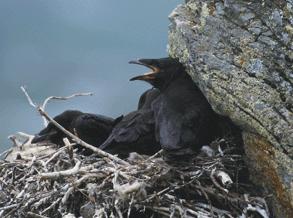The Raven Stone Spell February 10, 2017
Author: Beach Combing | in : Ancient, Medieval, Modern , trackbackLocation: tradition found in the Germanic regions of Continental Europe and Scandinavia, and also in parts of Britain.
Aim: The collection of the raven stone (korp-sten in Scandinavia, Lloyd 1854, 331) that will render the owner invisible, though note that the stone is also credited with bringing luck and curing humans and cattle of diseases: ‘[The stone] was in great repute for healing tumours, swellings, and sores, and also for curing distempers in cattle, horses, and sheep’ (Saxby 1893, 24-5).
Ingredients: A raven’s nest, a stout pair of climbing shoes.
Method
Spell from Germany
(i) Find a tree in which ravens nest (Swainson 1886, 91), taking care, first, to establish that both ravens are older than a hundred years and that they have young in the nest.
(ii) Climb the tree and kill one of the young (male, older than six weeks), climbing down quickly before the parents return.
(iii) The bereft parent will fly off and get a raven’s stone from the sea; or the raven will cough up the raven stone that it has hidden in its body. He or she will bring the stone and put it on or into the dead fledgling to bring it back to life.
(iv) Climb the tree again and take the stone from the nest getting away as quickly as possible.
(v) Opinions differ as to whether you must hold or swallow the stone to become invisible. Suggest trial and error.
Spell from the Tyrol (Swainson 1886, 91)
(i) Take a raven’s egg from a nest.
(ii) Boil the egg until is hard.
(iii) Replace the egg and a parent will bring the raven stone from the sea (to revive the egg?)
Dangers
Ravens can be aggressive, particularly while protecting their young…
Antiquity
The wide spread of references suggests that this spell dates back beyond the Middle Ages and into Germanic antiquity. However, the earliest reference found so far relates to a fourteenth-century Earl of Arundel who was offered a raven stone (Costello 1844, 583): note that the story is unlikely to be contemporary. There is a more certain reference to ‘an article of glamourie which [an ancestor] took out of a Corbie’s nest in the Corbie Heugh’ for Berwickshire in 1730 (Surgeon 1856, 23).
Help
Been looking for an elusive reference to this custom in Iceland but had no luck: there are just a few 19C asides drbeachcombing AT yahoo DOT com
For references and explanation of the project and tag index: Beach’s Book of Shadows.
12 Feb 2017: Bruce T ‘Did you consider the obvious, there are no trees to amount to anything Iceland? What trees that were originally there would be considered tallish maritime and subarctic scrub forest at best. That being said, try looking for similar tales among the Native peoples of Labrador where the people of Greenland and Iceland would sometimes travel for wood. The raven is just as important a mythological beast in the north of NA as it is in the same regions of Europe and Asia. The Canadians and the Scandinavians are positively over the moon when it comes to finding links between the Norse and Natives in Maritime and Arctic Canada. Discover a correlation between the two in a raven stone tale and you could likely find yourself with the resources to study trolls to your hearts delight.’
Beach replies: I’ve given the German version, I suspect all regions, and probably most parishes had their own twist. Perhaps in Iceland you had to climb cliffs! Apparently ravens rarely breed in Iceland, though, which would be more of a problem!



